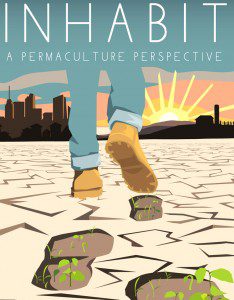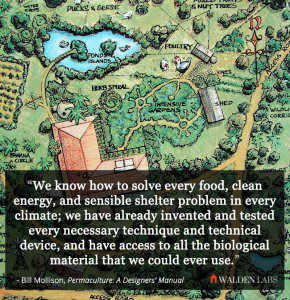Contributing writer for Wake Up World
“Though the problems of the world are increasingly complex, the solutions remain embarrassingly simple.” ~ Bill Mollison
A revolution is quietly sweeping across the globe, one that works in harmony with nature to create abundance for all life — including us. The method has been around for some time now, but it’s experiencing a resurgence of interest as ecological repair and regeneration becomes an urgent issue of survival for the planet.
Permaculture works within the structure and efficiency of nature — rather than attempting to dominate and control the natural world as we have in the past. This symbiotic relationship can be used in a wide-array of systems, from building and technology, to education and economics. However, it is best known for its application within agriculture, a practice that offers real life solutions to our food security and environmental troubles. This is the subject of a groundbreaking new documentary, Inhabit: A Permaculture Perspective.
[pro_ad_display_adzone id=”110028″]
Positive footprints
“All we need to live a good life surrounds us. Sun, wind, people, buildings, stones, sea, birds, plants. Cooperation with all these things brings harmony. Opposition brings disaster and chaos.” ~ Bill Mollison, co-developer of permaculture.
Unfortunately, instead of cooperating with nature, we’ve been in conflict since the industrial revolution. Scientists and researchers have been sounding the alarm about our path of ecological disaster for years. While the word “sustainability” generally evokes images of deprivation and damage control, permaculture approaches ecological balance from a stance of leaving a positive footprint, instead of no footprint at all.
The idea is beautifully captured by Inhabit, where individuals and groups who are “walking the permaculture talk” are profiled throughout the documentary. Ben Falk is once such person. Founder of Whole System Design Permaculture Research Farm in Vermont, United States and author of The Resilient Farm and Homestead, Falk has created what many consider a small slice of paradise.
The design of the farm is a far cry from traditional agriculture, the former being a type of strip mining more than anything else. Trees, land, plants and animals work together in permaculture, supporting ultimate well-being for everything and everyone involved. Falk helped the process along by creating swales (marshy depressions between ridges) to collect water and revitalize areas of land that were essentially barren. Before long, plant life began to thrive, creating another habitat and food source for animals and humans alike. By working with the natural design and water flow of the property, along with grazing animals and native plants, Falk was able to build a living ecosystem that not only regenerated the land, but also provides exceptional crop yield compared to conventional farming — without the use of harmful pesticides or toxins.
Granted, many of us are not quite at the point where we can move out to the country and create our very own bucolic oasis. Even so, the advantage of permaculture is that it can be applied to any situation — rural, urban or suburban.
Examples like Eric Toensmeier, co-author of Edible Forest Gardens and manager of Paradise Lot, a 1/10th acre permaculture educational garden in the heart of Massachusetts, demonstrate that suburbia is an excellent place for permaculture. Growing over 70 perennial greens and 40 different kinds of fruit, Toensmeier observed the bare backyard lot for a year before planting the garden in order to gain an understanding of the patterns of sun, wind and shade. The house on the property also utilizes a composting toilet, which provides rich soil for the plants and creates a closed-loop cycle of regeneration.
If suburbia isn’t your thing — or you live in a tightly packed area without a yard — permaculture can be adapted to rooftop gardens as well. These green spaces beautify and provide abundant food, while also diverting stormwater to the plants and rainwater collection barrels.
Dwaine Lee, an urban designer who teaches at the Five Boroughs Green Roof and founder of Power Polyculture, explains that a green roof garden mimics the natural world and provides an important service in helping to alleviate sewage overflow during rainstorms. Since storm water drains to the same system as sewage treatment, facilities become flooded with excess water during rainstorms, leading to the release of raw sewage into rivers, streams and the ocean — which seriously impacts the ecosystem.
The documentary highlights the fact that in New York City alone, there are one million buildings with 38,256 acres of rooftops, which are ripe for permaculture development. The possibilities are truly endless.
Another solution to the problem of storm water is to construct a rain garden. A teenager involved in the project describes how an old gas station was turned into a lush landscape, simply by diverting water from roadways during storms and structurally altering the land for the most efficient use of the water. The end result is a thriving garden of trees and plants which had previously been a wasteland.
Permaculture can also be taken out into the forest. Faced with an overabundance of cut wood, one man decided to use decomposition in his favor — by starting a shiitake mushroom farm with the logs. He then introduced ducks and geese into the mix to keep the slugs that eat mushrooms at bay. Again, all the elements work seamlessly in natural harmony to support one another.
Inhabit director Emmett Brennan leaves us with this final thought:
“Humanity is more than ever threatened by its own actions; we hear a lot about the need to minimize footprints and to reduce our impact. But what if our footprints were beneficial? What if we could meet human needs while increasing the health and well-being of our planet? This is the premise behind permaculture – a design process based on the replication of patterns found in nature.
“Inhabit is on the growing edge of media and cinema, presenting solutions to issues of food, water, medicine, governance, and more, and providing an impressive introduction to the permaculture worldview. The film illuminates the interdependence of all life and it presents an array of projects and people within this growing movement. “
Inhabit: A Permaculture Perspective ~ Trailer
‘Inhabit provides an intimate look at permaculture peoples and practices ranging from rural, suburban, and urban landscapes.’
Trailer courtesy of Costa on Vimeo.
Article sources:
- http://inhabitfilm.com
- http://permacultureprinciples.com
- http://www.cultureofpermaculture.org/blog/links/
- http://www.nytimes.com/2013/02/14/garden/a-permaculture-love-story.html?_r=0
Previous articles by Carolanne:
- Over 100 Scientific Studies Agree: Cannabis Annihilates Cancer
- Move Over Coconut, Macadamia is the New Health Superstar
- Why Every Parent Should Consider Unschooling
- The Greenhouse of the Future: Grow Your Own Food Year-Round With This Revolutionary System
- The Healing Code: Radically Improve Your Health With This Powerful Practice
- First U.S. City Produces More Electricity Than It Uses — With 100% Renewable Technology
- Dry Skin Brushing Can Strengthen Immunity, Spark Detoxification and Reverse Aging
- Why Everyone Should be Eating More Hempseed
- Autistic Boy with Higher IQ Than Einstein Discovers Gift After Removal from State-Run Therapy
- Enhance Spiritual, Mental and Physical Well-being with a Pineal Gland Detox
- DIY $2 Self-Watering Garden Bed – Grow Produce Easily, Even in the Toughest Conditions
- How Being Too Clean Can Lead to Cancer, Multiple Sclerosis, Celiac Disease and More
[pro_ad_display_adzone id=”110025″]
[pro_ad_display_adzone id=”110027″]








